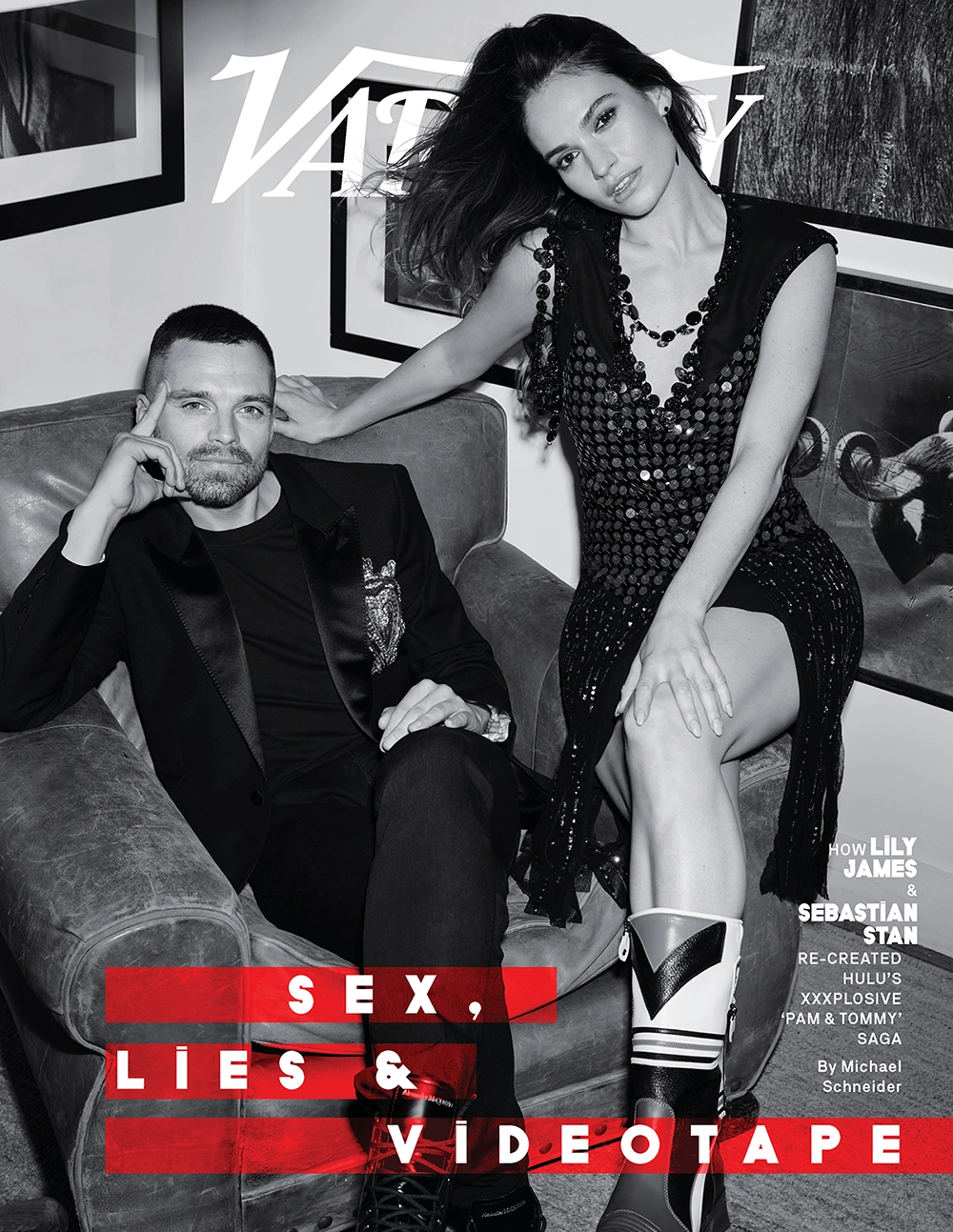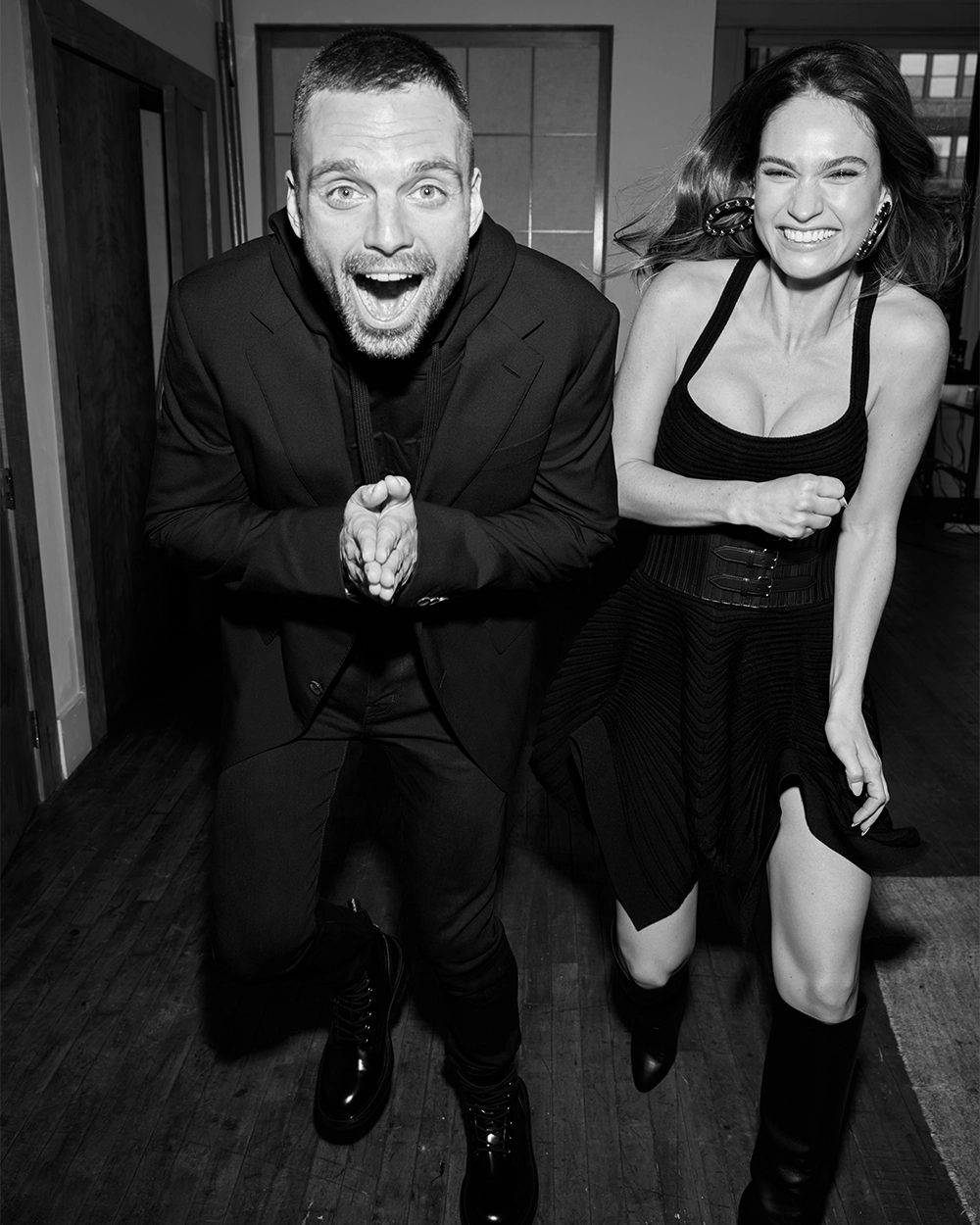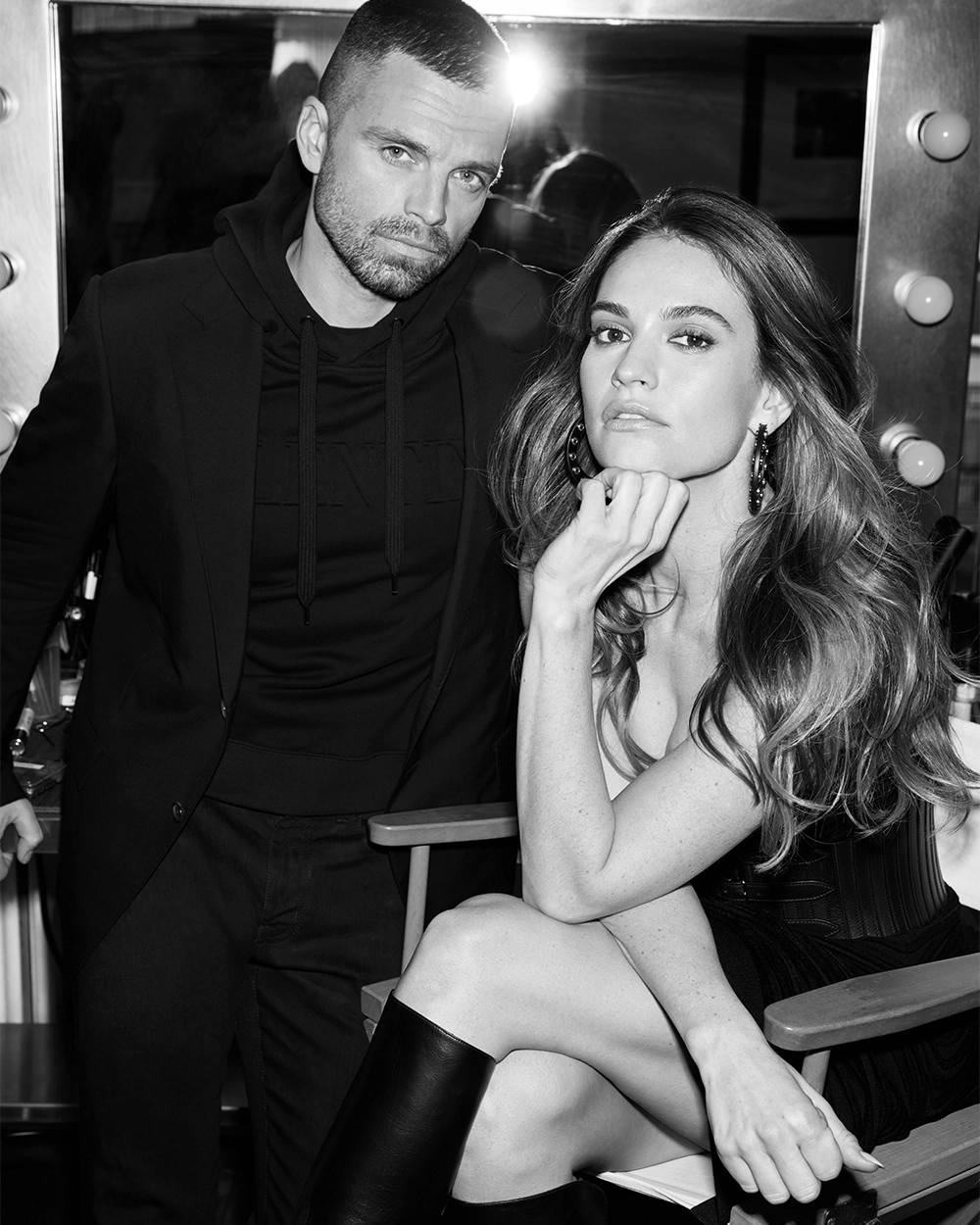Variety.com –Lily James and Sebastian Stan spent months working together on the set of Hulu’s “Pam & Tommy.” Yet when they recently reunited for a photo session it was a bit jarring to both actors.
“I barely met Sebastian out of Tommy Lee, and he barely met me out of my Pamela Anderson,” James says. “It was really surreal to do even the Variety shoot. We were like, ‘Oh, hey, so that’s what you look like!’”

That’s a testament to the amount of work James and Stan put into studying and emulating the real-life characteristics of Anderson and Lee — and just how well the production’s hair, makeup and wardrobe crews perfected their physical transformation. The look is so spot-on that when Hulu released the first photos of the “Pam & Tommy” stars in May, it quickly went viral on social media. “I was blown away,” Stan says. “The hair and makeup team deserve all the accolades that they can get.”
Of course, there’s a bit of irony to “Pam & Tommy” breaking the internet. In the series, which premieres Feb. 2, James and Stan play the “Baywatch” star and Mötley Crüe drummer as the couple meet, fall in love and then make a private recording that is ultimately stolen — becoming the first infamous viral video of a burgeoning online age.
The tape was shared and played at parties like it was contraband. Dubbed VHS copies spread across the world, as it was sold and traded on the then-brand-new World Wide Web. It later inspired a whole cottage industry of celebrity sex tapes, most of which were purposely leaked — unlike this one.
“I remember hearing about it as if it was like a Yeti,” says “Pam & Tommy” executive producer D.V. DeVincentis. “Like, you couldn’t necessarily assume it was true. It definitely had this sort of aura of a rumor, and something apocryphal. And then finally somebody put it in front of me and I saw it.”
And yet, there remain many misconceptions about what really happened, and who was really to blame. Over time, the actual story of the tape’s theft and how it victimized both Anderson and Lee — but at very different levels — has been lost to the memory of late-night punchlines and sophomoric snickering.

For the stars, producers and directors of “Pam & Tommy,” there was a sense that they were on a mission to correct that record — and in particular, perhaps find a little recompense for Anderson. “Pam & Tommy” is really three stories in one: a heist thriller retracing how the tape fell into the hands of a disgruntled construction worker; an unconventional love story about two celebrities whose relationship became more public than they ever could have imagined; and a societal critique on how the media, the justice system and the public all failed Pamela Anderson.
“It’s an important story, I think, from being able to understand what the impact of that media tornado really was,” says Stan. “For them as a couple but particularly for her as a woman. I can’t imagine what having a private home video stolen from you — how that wouldn’t impact a newlywed couple.”
“Pam & Tommy” is adapted from a 2014 Rolling Stone article by Amanda Chicago Lewis that finally told the true, although somewhat unbelievable, story of how the tape went public. Lewis managed to locate and extensively interview the man who pilfered the tape, Rand Gauthier — played in the series by Seth Rogen (who also executive produces) — and he revealed the implausible tale.
Gauthier, whose father memorably played Robin Hood in “When Things Were Rotten,” was an electrician working inside Lee’s Malibu estate until the rock star fired him and his team without pay. According to the article, when Gauthier returned to pick up his tools, Lee waved a shotgun in his face and refused to let him retrieve those items. That’s when the handyman, bent on revenge, hatched a preposterous scheme: He’d sneak onto the estate by wearing a fur rug over his back to make it look like the couple’s dog, then steal a safe hidden in their garage and drive it away in a rented U-Haul.
Somehow, the plan worked. Gauthier took the safe up into the mountains and found expensive watches, jewelry and guns — plus a mysterious Hi8 videocassette. After watching the tape, Gauthier, who had dabbled in adult films, figured he’d profit off his findings. He partnered with porn-producer pal Milton “Uncle Miltie” Ingley (played by Nick Offerman in “Pam & Tommy”) to find a buyer.

But even the sleaziest of adult film distributors weren’t interested — the tape was stolen goods, after all. That’s when Gauthier and Ingley turned to the newfangled internet, in the age of dial-up modems, and began mailing copies to buyers who found the duo’s anonymous, no-frills website. For seed money, they turned to crime boss Louis “Butchie” Peraino (as portrayed by Andrew Dice Clay in the series). But as people started recording and sharing the tape themselves, Gauthier never saw the riches he was expecting. (And when Peraino didn’t get his money back, Gauthier faced a whole new headache.)
“Most people who are acting badly are doing so from a very simple place,” Rogen says. “I wanted to play Rand as someone who has very little going on in his head. Someone whose ultimately evil acts aren’t done out of some amazing and deep thought process, but actually out of a complete lack of thinking and caring about how his actions would affect other people.”
Limelight president Dylan Sellers optioned Lewis’ story and brought it to Rogen and Evan Goldberg’s Point Grey shingle, and they immediately signed on — with an eye at first to casting James Franco as Lee. Former UTA agent and HBO exec Sue Naegle also hopped on board and brought along Annapurna, where she had just joined as head of TV.
“There’s nothing weirder than truth,” says Naegle, who was subsequently elevated to chief content officer at Annapurna. “The actual heist is so strange. But we also all looked at it and [had] the idea that there was a different way to look at this story through a 2022 lens versus how people might have felt in the ’90s.
“The opportunity was to tell something that was emotional and funny and true and hard,” she says. “There was an unfair cultural response in the ’90s. It bothered me then. And I think the chance to tell the story and to get people to see and understand how it was nobody’s business, it was nobody’s right.”
At that point, the producers agreed “Pam & Tommy” made sense more as a limited series (ultimately, eight episodes) to explore all of those themes. Robert Siegel, whose credits include “The Wrestler,” “Big Fan” and “The Founder,” was hired to take a first stab at the script: “I immediately connected with it — ’90s true crime with all the fun and nostalgia that it brings, plus substance underneath. This story was a way into exploring issues that are still incredibly relevant today. And that was exciting to me.”

Joining Siegel as co-showrunner was “The People vs. O.J. Simpson: American Crime Story” exec producer DeVincentis, who in 2016 had just tackled similar themes in that 1990s-set limited series. “I was definitely struck by how much her story sort of rhymed with Marcia Clark’s,” DeVincentis says. “With Pamela Anderson, what I always come back to is that [she and Lee] were doing the exact same thing. And filmed doing the exact same thing together. And one of them was slut-shamed and virtually drummed out of the business and turned into an unserious person. The other was given a new act and turned into this sex god. And the only difference between these two people [was] their gender. That’s it.”
Director and executive producer Craig Gillespie joined later in the process, bringing experience exploring how the media twisted the public perception of another maligned 1990s female public figure — Tonya Harding — in “I, Tonya.”
“I had the same preconceived notions I think a lot of audience members will have, which was, well, they were involved somehow, weren’t they?” Gillespie says of the sex tape’s circulation. “I just expected somewhere along the line, it must have worked out somehow for them. But then you see, they really got the wrong end of the stick on it. It was a terrible situation that they had to endure.”
As a kid in England, Lily James watched Pamela Anderson on “Baywatch” as lifeguard C.J. Parker, rescuing swimmers while running up and down the sunny beaches of Southern California. She remembers being in awe of the star.
“Sometimes you admire qualities in people that you feel you’re lacking, or you want to be more like,” James says. “And I’ve always felt there was this boldness to Pamela, this unashamed kind of authenticity. And even without knowing exactly what went on and the details of the tape, just who she kind of stands for, it feels so brave.”
The challenge of capturing Anderson’s essence intrigued the “Downton Abbey” alum enough to sign on. She immediately watched more “Baywatch” (“I binged hard,” she says) and quickly got to work earning her Ph.D. in all things Anderson, including her mannerisms, behavior and speech patterns.
“She talks really fast, and I would watch her interviews over and over again and annotate them, learn them and parrot along with her,” James says. “I wanted to get that energy and that impulsiveness and that spirit that she has when she’s in front of the camera.”

James says her “Pam & Tommy” boot camp was so intense that, despite all the prep work, she nearly quit the series. “I really wanted to pull out of this a week before,” she says, adding her feeling was “‘I can’t do it. I can’t do it.’ It just felt too frightening. But I think that’s a good place to work from because it keeps you growing and getting better, I hope.”
Stan was just as meticulous in plotting his transformation into Lee. When the actor, who had played Jeff Gillooly in “I, Tonya,” was recruited by Gillespie to play the Mötley Crüe rocker, he was puzzled at first: “I don’t have a single tattoo on my body,” he says. “So I was like, ‘What exactly is making you think that I can play this man?’ But I was intrigued enough to want to see why he was calling.
“When you’re playing somebody who’s from real life, the story is there; you’re a journalist at that point,” he adds. “You’re really researching all you can and trying to understand as best as you can.”
Stan began watching Lee interviews on YouTube, reading the rocker’s autobiography, “Tommyland,” and consuming the Mötley Crüe tell-all “The Dirt: Confessions of the World’s Most Notorious Rock Band.” But the biggest prep: Stan spent months learning to play the drums, Tommy Lee style, complete with the drumstick twirl.
“It’s not easy to do,” Stan says of Lee’s signature move. “My fingers were swollen for a good week and a half. I kept hitting myself in the head with it.”
Gillespie says he’s in awe of how prepared James and Stan were when they arrived to start shooting “Pam & Tommy.” “They were so committed, and also protective of their characters,” he says. “They never let up. They were constantly working with it, trying things and finding that nuance. It’s that thing of not doing an impersonation but trying to capture the essence of what the [real-life Anderson and Lee] were feeling. That’s the tricky part, and I think they both nailed it.”
But the first thing viewers will notice is the physical metamorphosis of James and Stan into Anderson and Lee. James spent a minimum of three hours in the makeup and hair chair to transform into Lee; on Monday mornings, she was there by 3:30 a.m. “I sometimes will see a picture of Lily in character, and it takes a second to just double-check in my mind that it’s not the real Pam,” Siegel says.
Stan, meanwhile, had to apply replicas of Lee’s ink every few days, and also went on a fast to slim down to the musician’s 1990s skinny physique. Both elements were key, given Lee’s habit of appearing shirtless in public. (In Episode 1, Stan’s wardrobe consists mostly of a G-string.)
“I looked at the tattoos as sort of being a costume in itself,” Stan says. Lee’s nipple rings were a no-go, however; the ones on Stan’s chest in the show are prosthetics.
The PR photo silenced any of the naysayers who had been questioning the unexpected casting of James and Stan, the latter just coming off “The Falcon and the Winter Soldier.”
Siegel says he didn’t understand the concerns, especially regarding James, who played Cinderella toward the end of her “Downton” run. “Pam’s smart, shrewd, kind of wholesome; she grew up in small-town Canada,” he notes. “She has a real sweetness to her, and almost an innocence that we wanted to come across. In the first reactions to casting Lily, people on Twitter were like, ‘Why didn’t they cast Megan Fox?’ I was like, no, they’re not getting it.”
Adds DeVincentis: “Also, it’s so enjoyable as creators and as an audience to experience reinvention. To watch somebody do something that is unexpected and that is a stretch, and that is new to them and to us as the audience. It’s a roll of dice. And I think people are going to be completely stunned at what they see with Lily James playing this role.”
As for Stan, Siegel says, “I thought there was a physical resemblance [to Lee]. And he is just a straight-up chameleon. He’s just one of these guys that disappears into characters.”
But we’re beating around the bush here. Once viewers catch Episode 2 of “Pam & Tommy,” they’ll all be talking about a specific scene in which Tommy, who had just met Pamela, wonders whether he’s falling in love — and discusses it in a heart-to-heart talk with his penis.
The penis tête-à-tête is inspired by an actual passage in “Tommyland”: In the series, Stan, as Lee, is seen carrying on a conversation with the chatty organ (voiced by actor Jason Mantzoukas).
“As much as I’d like to take credit for that, I was simply adapting a chapter from [Lee’s] memoir,” Siegel says. “I think it might be a first [for television]. There was gentle pushback, because you’ve got to push back a little when a talking penis is presented to you. But Hulu was extremely supportive.”
From a technical perspective, Gillespie describes shooting the scene as “just awkward. You’ve got four puppeteers working with an animatronic penis. And then, how much is too much, and do you start to lose his emotional torment of what’s going on? Hopefully it works.”
Meanwhile, Stan says he eventually approached the scene like working with any other acting partner. “By the end of it, I treated it like it was an intimate buddy conversation that one might have when they’re falling in love.”
Early on, “Pam & Tommy” depicts the carefree days of the start of Anderson and Lee’s relationship; the couple married in Cancun just four days after meeting. An intimacy coach helped James, Stan and Gillespie handle those sequences.
“You always have to approach those scenes with caution and make sure that you really trust the people involved,” James says. “First point of call is the script. Do we feel it’s necessary? Do we feel that it’s progressing the story? Is it crucial to the character? Then you work with the director and how you’re going to block it and the intimacy coach. I felt very supported in all those aspects. It was very collaborative; we really spoke through each choice of what we wanted to show. It’s very choreographed, which is really important too. Certainly, with ‘Pam & Tommy,’ and those crazy four days, we wanted to revel in that passion and explosion of their relationship. But we also didn’t want it to feel sensational or unnecessary.”
After that, the story turns from wedded bliss to horror as the leaked tape threatens Anderson’s career. Against Anderson’s wishes, the couple files lawsuits in an attempt to stop the tape from spreading — but that backfires, and only leads to more traumatic moments for Anderson as she faces awful questions in the deposition. Lee is also victimized, but the video came at a point when Mötley Crüe was struggling for relevancy in the grunge rock era, and it thrust him back in the limelight.
“In the aftermath of the tape, he didn’t have the same response culturally that she did,” Naegle notes. “He was a rock star. And then everyone thought he was a rock star with a rock-star dick. And that is not the world that she walked out into.”
As for the real Anderson and Lee, it remains to be seen how they’ll react to “Pam & Tommy.” In a now-deleted post, Anderson pal Courtney Love criticized the production for rehashing old wounds and causing “complex trauma” for Anderson all over again. James and the producers reached out to Anderson, but “she’s chosen not to engage,” Siegel says. “So we’ve respected her desire not to be involved.”
Stan had better luck in contacting Lee, but he declines to give details of their correspondence. “He seemed touched and appreciative that I took the time to even reach out and connect,” Stan says. Variety also reached out to both; Anderson’s camp didn’t respond, while Lee’s team declined comment.
Variety attempted to find Gauthier too, and left messages at phone numbers found online, but didn’t hear back. The “Pam & Tommy” team also did not connect with Gauthier. “Having optioned the article, we had what we needed,” DeVincentis says.

The “Pam & Tommy” stars and producers hope that Anderson and Lee watch the series through to the end and feel that their story is properly told.
“The show loves Pam,” Siegel says. “So I hope Pam loves the show. She’s certainly the hero of the show. At every step of the way, we’ve tried to do right by her. From the writing to working very closely with Lily, who kind of grew into our custodian of the character.”
“Pam & Tommy” also offers a more nuanced perspective on the tape itself. In one scene, Rand’s estranged wife, played by Taylor Schilling, points out that most of the tape isn’t even about sex, but instead is a chronicle of young, joyous love. “It’s like super wholesome; it’s romantic,” Schilling’s character says. It’s quite a contrast to the show’s scenes of “Baywatch” crew members laughing along to the tape as Pam walks by, or the anchors of “Hard Copy” and “Tonight Show” host Jay Leno making leering comments about it.
“It just made me want to work even harder to try and portray her not only authentically, but to do her the justice she deserves,” James says of Anderson. “It’s interesting to me that we are relooking at a lot of those stories from the ’90s through this more modern perspective. It’s the only way we can grow and learn and move forward.”
Stan says the show was done with the best intentions and based on research: “All we can do is just sort of wait and see how people perceive it — and certainly how [Anderson] perceives it.”